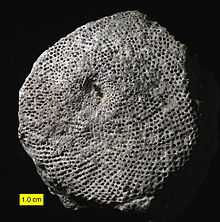Receptaculites
| Receptaculites Temporal range: 488–250Ma | |
|---|---|
| | |
| Receptaculitid from the Ordovician of Estonia. | |
| Scientific classification | |
| Domain: | Eukaryota |
| Kingdom: | Plantae |
| Division: | Chlorophyta |
| Class: | Ulvophyceae |
| Order: | Dasycladales |
| Family: | Receptaculitidae |
| Genus: | Receptaculites Blainville 1830 |
| Species[1] | |
| |
Receptaculites is the name-bearing genus for a group of conspicuous benthic marine genera, the Receptaculitidae, that lived from the Early Ordovician through the Permian, peaking in the Middle Ordovician. The group's phylogenetic origin has long remained obscure, but current understanding indicates that the Receptaculitidae were probably calcareous algae of the Order Dasycladales. Receptaculites and its relatives have a double-spiral, radiating pattern of rhombus-shaped plates supported by spindle-like objects called meroms. Fossils can usually be identified by the intersecting patterns of clockwise and counterclockwise rows of plates or stalk spaces, superficially similar to the arrangement of disk florets on a sunflower -- hence the common name "sunflower coral" (sic).
References
- ↑ "Family: Receptaculitidae". The Paleobiology Database. Retrieved 2011-08-15.
